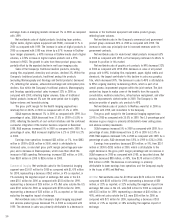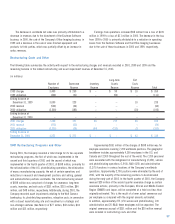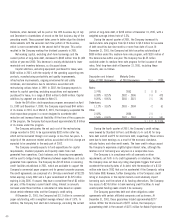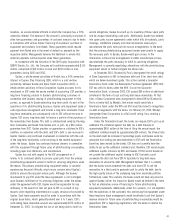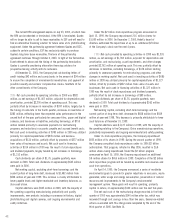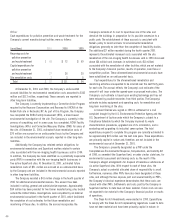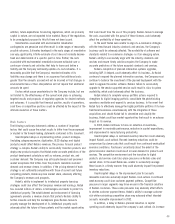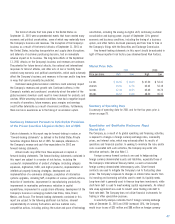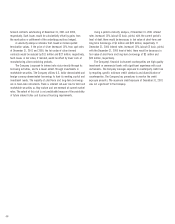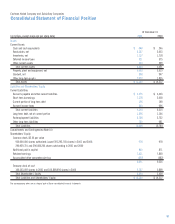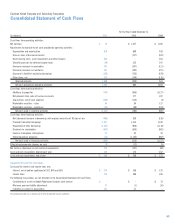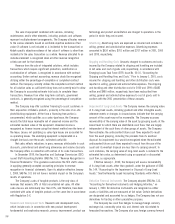Kodak 2001 Annual Report Download - page 48
Download and view the complete annual report
Please find page 48 of the 2001 Kodak annual report below. You can navigate through the pages in the report by either clicking on the pages listed below, or by using the keyword search tool below to find specific information within the annual report.
46
in capital spending may occur if more projects than planned were found
to generate significant positive returns in the future. Further, if the
Company deems it necessary to spend more on regulatory requirements
or there are unanticipated general maintenance obligations requiring
more capital spending than planned, the additional monies required
would create an adverse impact on Kodak’s cash flow.
Delays in Kodak’s planned improvement in manufacturing productivity
could negatively impact the gross margins of the company. A continued
weak economy could result in lower volumes in the factory than planned
which would negatively impact gross margins. Kodak’s failure to
successfully manage operational performance factors could delay or curtail
planned improvements in manufacturing productivity. If Kodak is unable to
successfully negotiate raw material costs with its suppliers, or incurs
adverse pricing on certain of its commodity-based raw materials, reduction
in the gross margins could occur.
Kodak’s planned improvement in supply chain efficiency, if delayed,
could adversely affect its business by impacting the shipments of certain
products in their desired quantities and in a timely manner. The planned
efficiencies could be compromised if Kodak expands into new markets
with new applications that are not fully understood or if the portfolio
broadens beyond that anticipated when the plans were initiated. The
unforeseen changes in manufacturing capacity could compromise the
supply chain efficiencies.
The risk of doing business in developing markets like China, India,
Brazil, Argentina, Mexico, Russia and other economically volatile areas could
adversely affect Kodak’s operations and earnings. Such risks include the
financial instability among customers in these regions, the political
instability and potential conflicts among developing nations and other non-
economic factors such as irregular trade flows that need to be managed
successfully with the help of the local governments. Kodak has typically
experienced longer accounts receivable cycles in emerging markets, in
particular the Latin American markets and the emerging markets of Europe.
Kodak’s failure to successfully manage economic, political and other risks
relating to doing business in developing countries and economically and
politically volatile areas could adversely affect its business.
In early 2002, the United States dollar was eliminated as Argentina’s
monetary benchmark, resulting in significant currency devaluation. The
Company engages in hedging programs aimed at limiting in part the
impact of currency fluctuations and does not expect that the devaluation
event in Argentina will result in a future material charge. However, there
can be no guarantee that economic circumstances in Argentina or
elsewhere will not worsen, which could result in future effects on earnings
should such events occur. The Company’s failure to successfully manage
economic, political and other risks relating to doing business in
developing countries could adversely affect its business.
The Company, as a result of its global operating and financing
activities, is exposed to changes in foreign currency exchange rates and
interest rates, which may adversely affect its results of operations and
financial position.
Competition remains intense in the imaging sector with respect to
consumer, commercial and health equipment, products and services. On
the consumer side, increased price competition has been driven somewhat
by consumers’ conservative spending behaviors during times of economic
weakness. Consumers have passed over branded products to private label
products. On the health and commercial side, aggressive pricing tactics
intensified in the contract negotiations as competitors were vying for
customers and market share domestically. Continued economic weakness
could also adversely impact Kodak’s revenues and growth rate. Failure to
successfully manage the consumers’ return to branded products if and
when the economic conditions improve could adversely impact Kodak’s
revenue and growth rate. If the pricing and programs are not sufficiently
competitive with those offered by Kodak’s current and future competitors,
Kodak may lose market share, adversely affecting its revenue and gross
margins.
The Company’s strategy to balance the consumer shift from analog
to digital, and the nature and pace of technology substitution could
impact Kodak’s revenues, earnings and growth rate. Competition remains
intense in the digital industry with a large number of competitors vying
for customers and market share domestically and internationally. Kodak
intends to continue new program introductions and competitive pricing to
drive demands in the marketplace. The process of developing new
products and services is complex and often uncertain due to the frequent
introduction of new products that offer improved performance and
pricing. Kodak’s ability to successfully transition products and deploy new
products requires that Kodak make accurate predictions of the product
development schedule as well as volumes, product mix, customer
demand and configuration. Kodak may anticipate demand and perceived
market acceptance that differs from the product’s realizable customer
demand and revenue stream. Further, in the face of intense industry
competition, any delay in the development, production or marketing of a
new product could decrease the advantage Kodak may have to be the
first or among the first to market. Kodak’s failure to carry out a product
rollout in the timeframe anticipated and in the quantities appropriate to
customer demand could adversely affect the future demand for its
products and services and have an adverse effect on its business.
The impact of continuing customer consolidation and buying power
could have an adverse impact on Kodak’s revenue, gross margins, and
earnings. In the competitive consumer retail environment, there is a
movement from small individually owned retailers to larger and
commonly known mass merchants. In the commercial environment, there
is a continuing consolidation of various group purchasing organizations.
The resellers and distributors may elect to use suppliers other than
Kodak. Kodak’s challenge is to successfully negotiate contracts that
provide the most favorable conditions to the company in the face of price
and program aggressive competitors.


